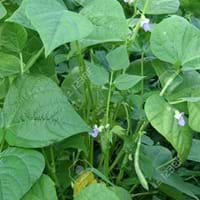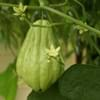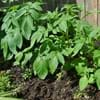Life Span
Perennial
Annual
Origin
Mexico, Central America
Central America, South America
Types
Not available
Black turtle,Cranberry,Flageolet
Number of Varieties
Not Available
Habitat
Hillside
Cultivated Beds
USDA Hardiness Zone
10-15
Not Available
AHS Heat Zone
12-3
Not Available
Sunset Zone
H1, H2, 14, 15, 16, 19, 20, 21, 22, 23, 24
A1, A2, A3, H1, H2, 1a, 1b, 2a, 2b, 3a, 3b, 4, 5, 6, 7, 8, 9, 10, 11, 12, 13, 14, 15, 16, 17, 18, 19, 20, 21, 22, 23, 24
Habit
Vining/Climbing
Vining/Climbing
Minimum Width
Not Available
Flower Color
Light Green
White, Pink, Lavender
Flower Color Modifier
Bicolor
Bicolor
Fruit Color
Green
Green, Tan
Leaf Color in Spring
Green
Green, Purple, Dark Green
Leaf Color in Summer
Green
Green, Dark Green
Leaf Color in Fall
Green
Green, Dark Green
Leaf Color in Winter
Not Available
Not Available
Leaf Shape
Irregular
Trident shaped
Plant Season
Spring, Summer, Fall
Spring, Summer, Fall
Sunlight
Full Sun, Partial Sun
Full Sun
Type of Soil
Loam, Sand
Loam, Sand
The pH of Soil
Acidic, Neutral, Alkaline
Neutral, Alkaline
Soil Drainage
Well drained
Well drained
Bloom Time
Late Summer, Early Fall, Fall
Indeterminate
Tolerances
Dry Conditions
Drought
Where to Plant?
Ground
Ground
How to Plant?
Seedlings, vegetative cuttings
Seedlings
Plant Maintenance
Medium
Medium
Watering Requirements
Medium
Requires regular watering
In Summer
Lots of watering
Lots of watering
In Spring
Moderate
Moderate
In Winter
Average Water
Average Water
Soil pH
Acidic, Neutral, Alkaline
Neutral, Alkaline
Soil Type
Loam, Sand
Loam, Sand
Soil Drainage Capacity
Well drained
Well drained
Sun Exposure
Full Sun, Partial Sun
Full Sun
Pruning
Remove damaged fruit, Remove damaged leaves, Remove dead branches, Remove dead leaves
Remove damaged leaves, Remove dead branches, Remove dead leaves
Fertilizers
All-Purpose Liquid Fertilizer
All-Purpose Liquid Fertilizer
Pests and Diseases
Aphids, Powdery mildew, Red blotch, Soft scales
Red blotch
Plant Tolerance
Dry Conditions
Drought
Flowers
Insignificant
Showy
Flower Petal Number
Single
Single
Foliage Texture
Coarse
Coarse
Foliage Sheen
Matte
Matte
Attracts
Bees, Flying insects, Not Available
Not Available
Allergy
Not Available
Food Allergy
Aesthetic Uses
Farmland
Not Available
Beauty Benefits
Good for skin
Not Available
Environmental Uses
Air purification
Air purification
Medicinal Uses
Acne, Anti-oxidant, constipation, Thyroid problems
anti-cancer, Diuretic, Homeopathy, Hypoglycaemic, Hypotensive
Part of Plant Used
Fruits, Leaves, Root, Stem
Leaves, Seedpod, Seeds
Other Uses
Culinary use, Used for its medicinal properties
Used as a dye, Used in biomass
Used As Indoor Plant
No
No
Used As Outdoor Plant
Yes
Yes
Garden Design
Edible, Herb, Vegetable, Tropical, Vine
Edible, Herb, Vegetable, Vine
Botanical Name
SECHIUM edule
PHASEOLUS vulgaris 'Blue Lake'
Common Name
Chayote, Choko, christophene, christophine, cho-cho, pipinola
common bean, French Bean, Kidney bean
In German
Chayote
Gartenbohne
In French
Chayote
Haricot
In Spanish
Chayote
Phaseolus vulgaris
In Greek
Chayote
Phaseolus vulgaris
In Portuguese
chuchu
Feijão
In Polish
Chayote
Fasola zwykła
In Latin
chayote
Phaseolus vulgaris
Phylum
Magnoliophyta
Magnoliophyta
Class
Magnoliopsida
Magnoliopsida
Family
Cucurbitaceae
Fabaceae
Clade
Angiosperms, Eudicots, Rosids
Angiosperms, Eudicots, Rosids
Subfamily
Cucurbitoideae
Faboideae
Number of Species
Not Available
Importance of Chayote and Pole Bean
Want to have the most appropriate plant for your garden? You might want to know the importance of Chayote and Pole Bean. Basically, these two plants vary in many aspects. Compare Chayote and Pole Bean as they differ in many characteristics such as their life, care, benefits, facts, etc. Every gardener must at least have the slightest clue about the plants he wants to plant in his garden. Compare their benefits, which differ in many ways like facts and uses. The medicinal use of Chayote is Acne, Anti-oxidant, constipation and Thyroid problems whereas of Pole Bean is anti-cancer, Diuretic, Homeopathy, Hypoglycaemic and Hypotensive. Chayote has beauty benefits as follows: Good for skin while Pole Bean has beauty benefits as follows: Good for skin.
Compare Facts of Chayote vs Pole Bean
How to choose the best garden plant for your garden depending upon its facts? Here garden plant comparison will help you to solve this query. Compare the facts of Chayote vs Pole Bean and know which one to choose. As garden plants have benefits and other uses, allergy is also a major drawback of plants for some people. Allergic reactions of Chayote are Not Available whereas of Pole Bean have Food Allergy respectively. Having a fruit bearing plant in your garden can be a plus point of your garden. Chayote has no showy fruits and Pole Bean has showy fruits. Also Chayote is not flowering and Pole Bean is not flowering . You can compare Chayote and Pole Bean facts and facts of other plants too.





